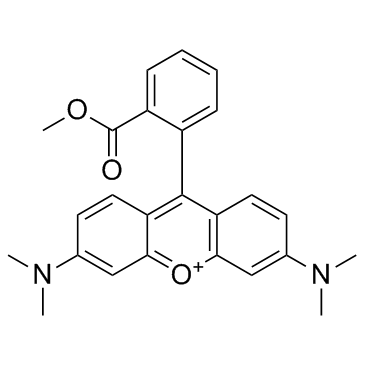115532-49-5
| Name | TMRM |
|---|
| Description | TMRM is a cell-permeant cationic lipophilic red fluorescent dye (λex=530 nm, λem=592 nm). |
|---|---|
| Related Catalog | |
| In Vitro | TMRM is a fluorescent probe (excitation, 530±21 nm; emission, 592±22 nm). The fluorescence signal in the presence of safranin or TMRM shows a slight decrease after the addition of glutamate, indicative of increased polarization of the mitochondrial inner membrane. In the presence of TMRM (2 μM) the coupled respiration with Complex I substrates or upon the addition of Complex II substrate is decreased by 27%[1]. Exposure of hippocampal cultures to low concentrations of TMRM (50 to 500 nM) for 1 to 3 hours results in selective staining of mitochondria in both neurons and the underlying glial cells. Exposure of hippocampal cultures to high concentrations of TMRM (1 to 25 µM) stains mitochondria selectively and quickly, reaching a plateau after 5 to 10 min. Low concentrations of TMRM (50 to 200 nM) do not induce apoptosis, whereas higher concentrations (0.5 and 2.5 µM) enhance apoptosis (KD = 500 nM)[2]. |
| Cell Assay | Cultures are exposed to Millipore-filtered solutions (0.22 µm) containing TMRM and/or drugs for 1 hr at 37°C (except the experiment involving different durations of exposure to TMRM). After treatment, solutions are removed and growth media reapplied under sterile conditions, and cultures are post-incubated for 18 hours at 37°C (except for the experiment involving analysis at different time points after exposure). Cells are then stained with 2 mg/mL bisbenzimide for 20 min at room temperature. Coverslips are subsequently washed in saline and imaged using 2P microscopy. Apoptotic cells are identified as brightly fluorescent nuclei under UV excitation indicating DNA fragmentation. Cell survivability is calculated as the percentage of live, unstained cells (±SD) in five microscopic fields per treatment[1]. |
| References |
| Molecular Formula | C25H25N2O3 |
|---|---|
| Molecular Weight | 401.48 |
